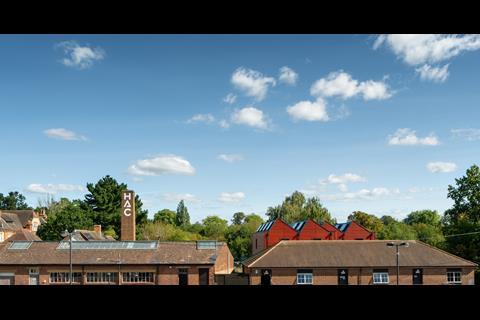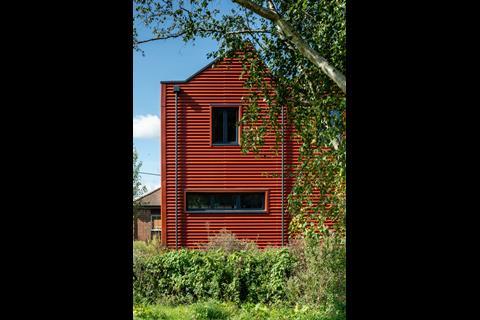£1.8 million Greenhill Building replaces a temporary facility and introduces flexible teaching and event spaces
Chris Dyson Architects has completed the Greenhill Building, a new £1.8 million teaching and events facility at Harrow Arts Centre in north-west London.
Located behind the Grade II-listed Elliott Hall, the building replaces a portacabin and provides spaces for community use, from dance classes to workshops.
It is constructed entirely from cross-laminated timber (CLT), which was chosen for its low-carbon credentials and speed of construction.
Prefabricated off-site, the system minimised the need for foundations and enabled the entire main build to be completed in less than nine months.
The two-storey, L-shaped building incorporates teaching rooms at ground level that open onto a courtyard. The upper floor is designed to maximise natural lighting through the use of north light.
Heating and ventilation systems are manually controlled, and lighting is sensor-operated to reduce energy consumption. The roof will feature solar photovoltaic panels to generate power for the electric heating.
History of the site
Harrow Arts Centre (HAC), located in Hatch End, Pinner, occupies the surviving buildings of the former Royal Commercial Travellers’ School. Built in 1904 as the school’s assembly hall, Elliott Hall was designed by Herbert Osborn Cresswell.
Following the school’s closure in 1967, the site served various educational purposes before reopening as an arts venue in 1988. Today, HAC is the borough’s only dedicated performing arts venue, managed by Harrow Council since 2007. It also hosts council meetings, following the closure of Harrow Civic Centre in 2023.
The design draws inspiration from the site’s agricultural heritage, formerly part of a commercial travellers’ school that included a farm. This heritage is reflected in the red corrugated fibre cement cladding, a material commonly associated with barns.
“The architecture is unashamedly new, but we were sensitive to the site’s heritage and patchwork of buildings,” said Chris Dyson, founder of Chris Dyson Architects. “We embraced the challenge of doing more with less, creating more useful space for people but using less material and energy.”
He added, “Some visitors have said the serrated roof reminds them of a factory, which seems appropriate for Harrow’s creative engine – this campus is such a hub for arts and cultural industry in the area, we’re delighted to have played a part in helping to secure its future.”
The project also addresses longstanding site issues, including flooding. A swale channels excess water to an underground tank, and landscaping enhancements form part of a broader rewilding initiative.
Structural engineers Webb Yates collaborated with the architects and sub-contractor to optimise the timber frame, seeking to reduce material use. Associate director Alex Lynes noted, “By designing the building holistically, complexity was reduced, cutting costs and carbon. The timber frame underwent several changes by the specialist sub-contractor to aid buildability and reduce material usage.”
The building is expected to generate 93% fewer CO2 emissions annually than the baseline set by Building Regulations Part L.
Project team
Architecture: Chris Dyson Architects
Client: London Borough of Harrow on behalf of the Harrow Arts Centre
Structural, Civil and MEP engineer: Webb Yates
Kinnear Landscape Architects (landscape)
Studio Emmi (signage and wayfinding)
PT Projects (QS and Contract Administrators)
GHD (transport planning)
Fire safety: CWB
Cost consultants and Contract Administrators: PT Projects
Project details
Appointment year: 2019
Completion year: 2023 build, 2024 landscaping
Site area: HAC Campus = 21,030m²
Building area: GEA 256m² x 2 = 512m² (5,511ft²); GIA 230m² x 2 = 460m² (4,951ft²)
Structure: Glulam timber frame with CLT wall, floor, and roof panels
Budget: £1.8 million
Programme: base build construction, 9 months
BREEAM: not assessed, however, the MEP design and thermally efficient construction result in the building having an estimated 93.04% reduction in CO₂ emissions per year from the Building Regulations Part L baseline






























No comments yet